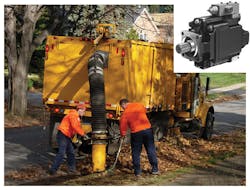The 95 cc/rev VP1 Series load-sensing truck pump from Parker Hannifin is intended for mobile applications where power and precise control of multiple functions is required. Built to meet the needs of today's high-pressure systems, such as those used on cargo cranes, the variable-displacement pump is likewise suited for forestry equipment, sewage trucks, and road maintenance vehicles, such as snow plows and salt spreaders.
The compact VP1-095, which can be mounted directly to a truck PTO, supplies the hydraulic system with exactly the right amount of oil needed to improve performance and control. Thanks to the pump's variable flow capability, heat generation is significantly reduced. This can eliminate the need — and expense — of an oil cooler while reducing fuel consumption at the same time.
The 95-cc displacement is an expansion of the VP1 family that includes 45, 75, and 120 cc frames. Rated for continuous operation at pressures up to 6090 psi, the VP1-095 offers a variable flow up to 52 gpm. The design of the VP1-095 allows producing a pump rated higher than other pumps in the family (VP1-045, VP1-075 = 5800 psi/400 bar; VP1-120 = 5075 psi/350 bar) and weighing 2.2 lb. less than the 75cc pump.
Field tests comparing Parker's VP1 Series pumps to fixed displacement pumps show substantial efficiency gains. Operating on a heavy-duty cargo crane, heat loss varied between 60% to 65% using fixed displacement pumps. The variable-displacement pumps reduced these figures to 25% to 30%. Besides fuel savings, the lower temperature strain contributes to longer pump life and decreased maintenance costs. Furthermore, fewer exhaust emissions may contribute to a cleaner environment.
Ideal for all load-sensing valve systems, the VP1-095 also holds potential to increase mobile equipment productivity by delivering smooth system operation due to its highly responsive pilot assembly. The pump's 11-piston design contributes to low noise and pulsation, thus reducing the potential need for — and expense of — sound insulation, which help equipment comply with OSHA codes and standards.
For more information about the VP1 Series truck pumps, call (937) 644-3915 or visit www.phpump.com.


